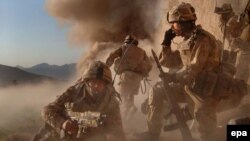LASHKAR GAH, Afghanistan – Afghan officials say government forces have launched an operation to win back territories lost to the Taliban in many parts of the southern province of Helmand.
Provincial spokesman Omar Zhwak said the offensive began in many northern and southern districts of the vast region this week.
Zhwak told Radio Free Afghanistan on June 23 that the operation aims to recapture districts and territories recently lost to the Taliban or that are under a severe threat of insurgent takeover.
"We have already made some progress, and aside from causing enemy casualties, we have also captured their weapons and ammunition," he said. "One policeman was killed and one has been injured in the fighting so far."
The offensive aims to cleanse the northern Nawzad, Sangin, Nahr-e Saraj, Kajaki, Baghran, Marjah, and Musa Qalah districts of Taliban presence. In the south the offensive is concentrated on Khan-e Nashin and Dishu districts.
Local sources say that during the past 14 years the Taliban has been in charge of Baghran and Dishu districts in Helmand. Baghran has been a Taliban stronghold since the emergence of the movement in mid-1990s. Dishu borders Pakistan and has remained a major crossroad for insurgents, drug traffickers, and smuggling since the Soviet occupation of Afghanistan in the 1980s.
In recent weeks the Taliban have also made forays into Sangin and Kajaki districts. Sangin is unlikely to fall because of a large Afghan army base there. But the insurgents are seriously threatening a large hydroelectric dam in Kajaki, which is vital for irrigation and electricity generation across southern Afghanistan.
Lawmaker Abdul Majid Akhundzada represents Kajaki in Helmand's provincial council. He told Radio Free Afghanistan that while the Taliban have not launched large attacks in the district this week, the Kajaki dam and other parts of the region are still being threatened.
"The threat persists because nothing is being done to turn the Taliban tide," he said. "We have not seen any government reinforcements or other measures to push the Taliban out of our district."
In early June the Taliban captured the main road to Kajaki. The insurgents still control the road but were repulsed when they tried to take over the district center.
Abdul Wadud Nijrabi is the Afghan Army commander leading the offensive in Kajaki and Sangin districts. He says the insurgents are swelling their ranks by brining in fighters from neighboring regions.
"This is how they are trying to overwhelm us, but we are determined to fight them off," he said.
In Musa Qalah, another district in northern Helmand, the Taliban tried to capture the district center on June 17 after intense fighting including a gun battle inside the district police headquarters.
In one of the largest military offensives undertaken by Afghan forces so far, the Afghan National Army, police, and intelligence swept northern Helmand for nearly two months from mid-February to early April. This operation, called Zulfiqar, however, failed to prevent the Taliban from launching their traditional spring offensive in April.
Helmand's resident says that while the operation failed in the northern districts, it improved security around the provincial capital Lashkar Gah in central Helmand.
For more than two decades the fertile valleys of Helmand have produced most of the world's opium and heroin. It borders Pakistan and is close to Iran, making it into a lucrative route for the drugs trade.
In the 1990s, conflicts between strongmen in the region fostered the rise of the Taliban. The insurgents still count the province as one of their main recruiting grounds.
Tens of thousands of international troops, mostly British and American, have failed to rein in Taliban violence, poppy cultivation, and drug trafficking in Helmand.
Abubakar Siddique wrote this story based on Mohammad Ilyas Dayee's reporting from Lashkar Gah, Helmand.








